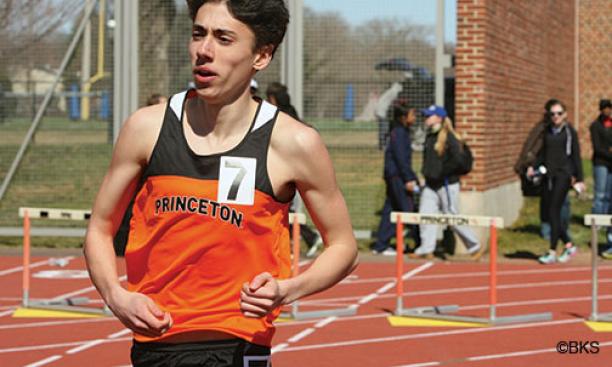

Shortly before the mile run at Boston University’s Valentine Invitational in February, Princeton’s lone miler escaped to a nearby supermarket. Resting on a stool by the hot buffet, Michael Williams ’14 sought temporary relief from the pre-race hubbub — and from his own anxieties. Relegated to heat three (the third-fastest group), Williams sensed the twilight of a career plagued by injury and underperformance. “I have never been that nervous,” he said.
The starter’s gun fired, and Williams hovered in the middle of the pack until the back stretch of the final lap. Then, narrowly avoiding collision, he “unleashed it,” he said — a scorching kick. He tore down the straightaway as the announcer counted the seconds approaching the revered four-minute barrier: “five, six, seven ...” Crossing the finish line, Williams craned his head back and threw his hands up triumphantly as the crowd erupted. The clock read 3:59.63. Covering his face, Williams crumpled to the ground. “I remember thinking, this is what I’ve wanted to do for so long,” he said, “and now it’s done.”
Prevailing wisdom once held that running a mile under four minutes was impossible — that a sustained speed of more than 15 miles per hour imposed a formidable if not fatal runner’s wall. When, in 1954, a medical student named Roger Bannister proved otherwise (3:59.4), it was heralded among the greatest sporting achievements ever.
Since then, a few hundred Americans have managed the feat, including six other Tigers: Craig Masback ’77, Bill Burke ’91, Scott Anderson ’96, Donn Cabral ’12, Joe Stilin ’12, and Peter Callahan ’13. Jason Vigilante, Princeton’s cross country and assistant track coach, expects more. “It took a lot of hard work on Michael’s part,” he said. “But if he can do it, others can, too.”
Williams fell into the sport as a gangly high school athlete. When he arrived at Princeton, “no one on the team thought I was serious,” he recalled. When a coach inquired about his training, Williams noted three workouts. The coach asked, “Last week?” Williams confessed: “Over the whole summer.”
The art of the mile demands training with long-distance runners (logging miles for stamina) and short-distance ones (sprinting intervals for speed).Williams has been savoring victory, speed, austerity — if not running itself. “The sport is so brutal,” he said.
Nevertheless, the work has paid off: In 2013 Williams ran the first leg (1,200 meters) for Princeton’s distance-medley relay team that won the NCAA national title, and he was one of 16 runners invited to compete in the mile in the 2014 NCAA national indoor championships March 14.
Princeton will defend its outdoor Heps title May 10–11 in New Haven. Beyond that, Williams said, he’s considering professional running for the first time: “The Olympics are in two years.”
